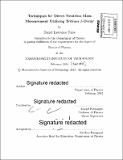| dc.contributor.advisor | Joseph Formaggio. | en_US |
| dc.contributor.author | Furse, Daniel Lawrence | en_US |
| dc.contributor.other | Massachusetts Institute of Technology. Department of Physics. | en_US |
| dc.date.accessioned | 2015-10-14T15:05:05Z | |
| dc.date.available | 2015-10-14T15:05:05Z | |
| dc.date.copyright | 2015 | en_US |
| dc.date.issued | 2015 | en_US |
| dc.identifier.uri | http://hdl.handle.net/1721.1/99313 | |
| dc.description | Thesis: Ph. D., Massachusetts Institute of Technology, Department of Physics, 2015. | en_US |
| dc.description | In title on title-page, "[beta]" appears as the lower-case Greek letter. Cataloged from PDF version of thesis. | en_US |
| dc.description | Includes bibliographical references (pages 265-270). | en_US |
| dc.description.abstract | This thesis documents efforts performed in the service to two direct neutrino mass experiments, namely KATRIN at the Karlsruhe Institute of Technology in Karlsruhe, Germany and Project8 at the University of Washington in Seattle. These experiments aim to utilize a measurement of the shape of the endpoint of the tritium beta decay spectrum to determine the neutrino mass, which is a technique that relies only on basic kinematics and enjoys a long and distinguished history. Additionally, these experiments utilize classical electrodynamics in their analysis of the beta electron spectrum, at KATRIN through the use of a MAC-E filter and at Project8 through magnetic confinement of electrons within a waveguide and the measurement of their weakly energy dependent relativistic cyclotron frequencies, which is an entirely new technique. In the thesis, both experiments are described in detail with particular attention paid to the components involved in energy analysis. Exploiting these experiments' similarities, an extensive simulation package called KASSIOPEIA has been prepared, which is the principal effort described herein. KASSIOPEIA is applied to both KATRIN and Project8, which in the case of KATRIN delivers valuable and detailed information regarding the performance of the electrostatic spectrometers used there, in particular the main and monitor spectrometers. In its application to Project8, KASSIOPEIA is used to determine precise electron trajectories, which can be used to simulate the signals these electrons induce in the waveguide. This thesis also includes experimental results obtained at the monitor spectrometer of the KATRIN experiment, which demonstrate the efficacy of the magnetic pulse technique at ejecting problematic stored electrons at MAc-E filters. The magnetic pulse technique relies on using a set of external aircoils surrounding a MAC-E filter to reverse and rapidly restore the magnetic field in the spectrometer symmetry plane, causing stored particle to hit the vessel walls. Owing to its success as demonstrated in this work, this technique will be employed at the main spectrometer during the upcoming data taking run at KATRIN. Finally, this thesis presents some results from the inaugural run at Project8, which showed that the theretofore undemonstrated technique, named Cyclotron Radiation Emission Spectroscopy (CRES), is capable of detecting the signal a single electron excites in a waveguide as it its magnetically trapped inside. In the history of tritium based neutrino mass experiments this technique is unique, and presents an entirely complimentary approach to that used at KATRIN. Based as it is on a frequency measurement, the technique shows great promise to mature into an extremely high precision form of electron spectroscopy, with many applications throughout nuclear physics. | en_US |
| dc.description.statementofresponsibility | by Daniel Lawrence Furse. | en_US |
| dc.format.extent | xxii, 270 pages | en_US |
| dc.language.iso | eng | en_US |
| dc.publisher | Massachusetts Institute of Technology | en_US |
| dc.rights | M.I.T. theses are protected by copyright. They may be viewed from this source for any purpose, but reproduction or distribution in any format is prohibited without written permission. See provided URL for inquiries about permission. | en_US |
| dc.rights.uri | http://dspace.mit.edu/handle/1721.1/7582 | en_US |
| dc.subject | Physics. | en_US |
| dc.title | Techniques for direct neutrino mass measurement utilizing tritium [beta]-decay | en_US |
| dc.type | Thesis | en_US |
| dc.description.degree | Ph. D. | en_US |
| dc.contributor.department | Massachusetts Institute of Technology. Department of Physics | |
| dc.identifier.oclc | 922938372 | en_US |
